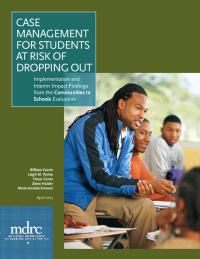Case Management for Students at Risk of Dropping Out
Implementation and Interim Impact Findings from the Communities In Schools Evaluation

Too many students drop out and never earn their high school diploma. For students at risk of dropping out, academic, social, and other supports may help. Communities In Schools seeks to organize and provide these supports to at-risk students in the nation’s poorest-performing schools, including through “case-managed” services. School-based Communities In Schools site coordinators identify at-risk students, work with them individually to assess their needs, develop a case plan to meet those needs, connect them with supports in the school and community based on that plan, and monitor their progress to ensure that their needs are met.
This report, the first of two from a random assignment evaluation of Communities In Schools case management, focuses primarily on the implementation of case management in 28 secondary schools during the 2012-2013 school year. The implementation research yielded several key findings:
- The services provided by Communities In Schools were an important component of the participating schools’ support systems for students, but there were also many services provided by school staff members and other external partners.
- Over about 30 weeks, case-managed students received an average of 19 service contacts totaling 16 hours. More than 75 percent of case-managed students received academic services, about 60 percent received social or life skills support, and half received behavior support.
- "Higher-risk" case-managed students — those who failed a course or were chronically absent or suspended in the previous year — did not receive more case-managed services than others.
- Compared with those randomly assigned to the non-case-managed group, case-managed students reported participating in more in-school support activities in several categories, including academically and behaviorally focused meetings with adults and mentoring.
The report also includes interim one-year findings about case management’s impact on student outcomes.
- Case management had a positive impact on students’ reports of having caring, supportive relationships with adults outside of home and school, the quality of their friendships, and their belief that education matters for their future. But for most outcomes concerning students’ interpersonal relationships and educational perspectives — relationships with caring, supportive adults at home or school and educational attitudes, engagement, goals, and expectations — there were no notable differences between case-managed and non-case-managed students.
- After one year, Communities In Schools case management has not yet demonstrated improvement in students’ attendance or course performance, or reduced behaviors that lead to disciplinary action — outcomes associated with increasing their chances of graduation. It is possible that case management could take more than a year to show an effect.
This report concludes with suggestions for improvement for Communities In Schools based mainly on the implementation findings. The next report will present two-year impact findings and more about the implementation of case management in the 2013-2014 school year.






